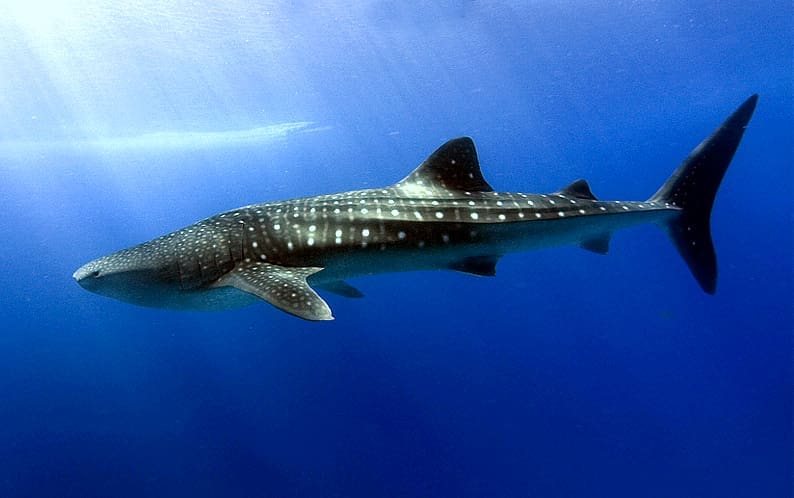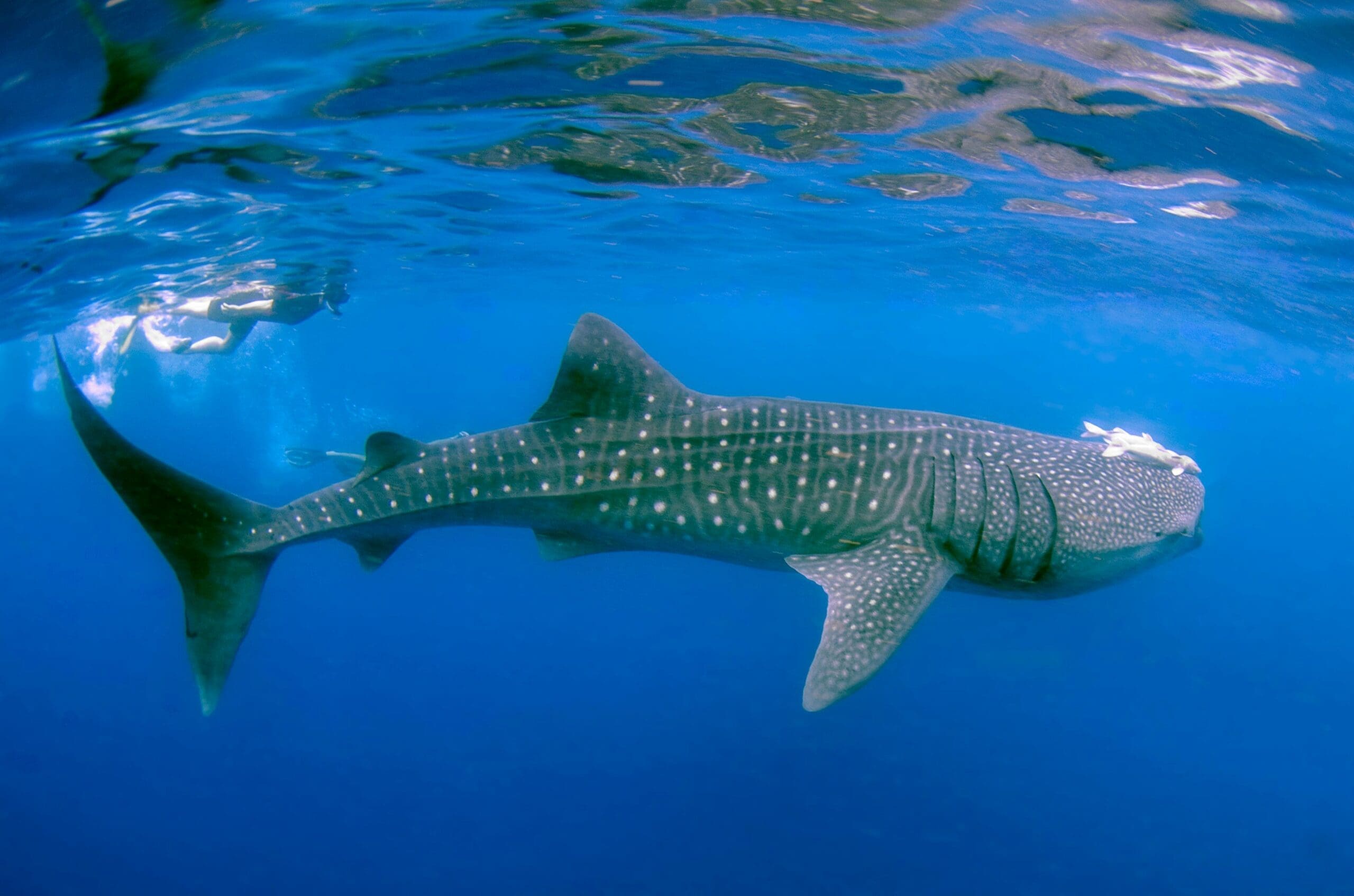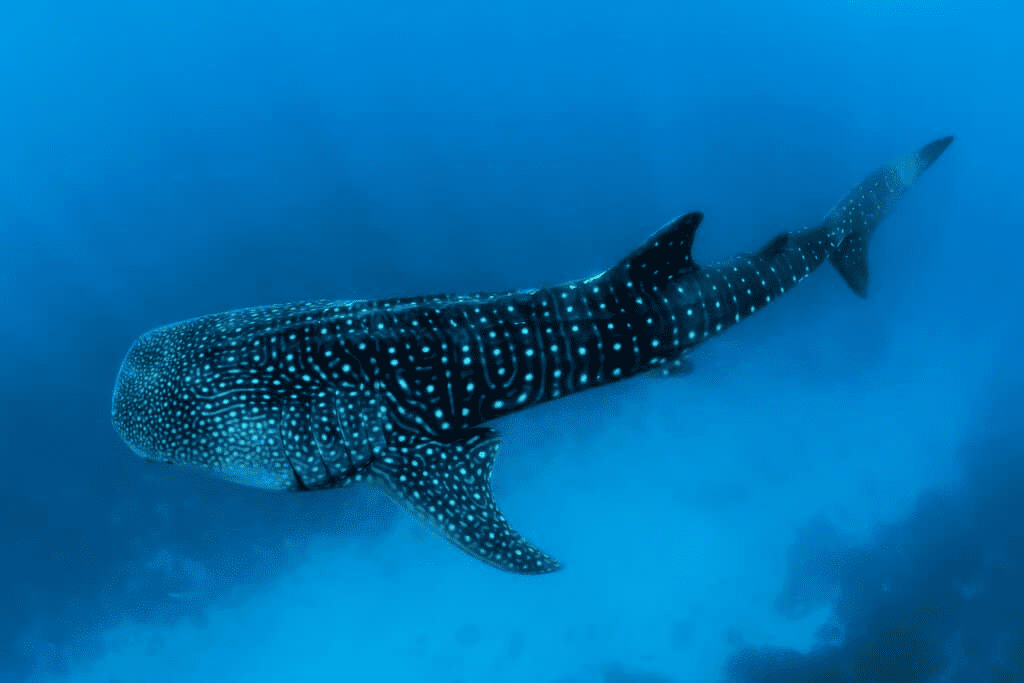What creature is the largest of its kind, sports beautiful patterns, and holds a reputation for being a ‘gentle giant’?
The whale shark!

Filter feeding for giants
The majestic whale shark is famed for being the largest fish in existence. With a length of up to 33 feet and weight up to 20 tons, they are not only the largest living fish, but thought to be the largest fish that ever lived on this planet. Though their name might suggest otherwise, whale sharks are not a type of whale at all, but instead a member of the shark family. It is their enormous size (akin to a school bus) that led them to be compared with whales.
Like their other shark relatives, these creatures are excellent swimmers and true masters of the deep. People are coming to recognize that all sharks, even carnivorous species that hunt marine mammals, fish, or other invertebrates, have been unfairly mischaracterized as threatening, and whale sharks are another species you need not be afraid of.
In fact, one of the most fascinating traits of the whale shark is its diet. Despite their own large size, whale sharks subsist on some of the smallest ocean inhabitants, plankton. Much like the enormous blue whale, whale sharks are a living example of one of the most interesting links in the food chain, where nutrients are cycled from microscopic life to macroscopic organisms.
They filter-feed by opening their mouths and letting plankton-rich waters pass through, as well as ingesting other small fish or unlucky invertebrates along the way. But even in this habit they are unique. Whale sharks use a technique called “cross-flow filtration,” in which particles do not actually catch on the filter (the way it works when we drain pasta through a strainer or breathe through an N95 mask). Instead, water is directed away through the gills while particles move towards the back of the mouth. A bolus (or a spinning ball of food) grows in size as more particles are concentrated, finally triggering a swallowing reflex in the throat. This avoids clogging any filters in the process and is a particularly efficient method of filter feeding.
Because they are so large, whale sharks need a lot of food to sustain themselves, and so they journey long distances in order to eat enough for their great big appetites. They can be observed throughout the world in warm tropical waters and tend to lead solitary lives. Where there is an abundance of plankton, however, whale sharks are sure to follow. For example, in the Springtime many whale sharks migrate to the continental shelf of the Central West Coast of Australia, where Ningaloo Reef is the site of a great coral spawning that produces water rich with plankton for our giant fishy friends to enjoy.

Big fish in a complex sea
The whale shark contributes to nutrient cycling throughout its lifespan, providing important benefits to the ecosystems they are a part of. Some of the warm tropical waters that whale sharks call home tend to be low in nutrients and productivity, and in these areas whale sharks can make a big difference due to their size and force. As they undertake migrations or even as they go about daily swimming and feeding activities, their motion stimulates small ocean currents that can help nutrients travel from areas of high productivity to waters where they are much less concentrated.
Their own eating habits rely on an abundance of microscopic creatures and the nutrients they metabolize, and eventually each mighty whale shark passes on and becomes food itself, returning those nutrients to the ocean food web. After death, whale sharks sink to the ocean floor and the benthic organisms that reside there find food and shelter in the great carcasses. It can take decades for this decomposition to occur, and in the meantime hundreds of creatures benefit from the habitat and nutrients left behind.
In life as well, whale sharks can provide refuge to smaller species of fish that travel around their great bodies, taking advantage of the shelter these gentle giants create. As largely docile creatures, whale sharks can be quite approachable and playful with divers who are also interested in tagging along:
In a couple of instances, humans have even pushed their luck so far as to ride along on a whale shark’s back! Such close contact is discouraged by conservationists to protect the personal space of these beautiful animals, but whale sharks’ friendly reputation remains.
Though they may be steady, generous members of the ocean community, whale sharks are struggling to survive in changing conditions. They are an endangered species, and while some protections for these creatures have been enacted across the coastal waters of the world, they are still hunted for meat, fins, and oil, or captured or killed as bycatch in industrial fishing operations. Whale sharks also suffer from the plastic pollution in our oceans, as microplastics mingle with the food they rely on. Like the rest of us, whale sharks need clean, healthy, abundant environments in which to live and co-create.

Unique beauties
Whale sharks may be known for their size, but that’s not the only special thing about their anatomy and appearance. Each whale shark sports a beautiful pattern of white markings on its dark gray back. Not only does this make these creatures look like giant mobile modern art pieces, but the patterns also uniquely identify whale shark individuals.
It is not conclusively determined why whale sharks carry these unique signatures, their own version of the human fingerprint. Some scientists speculate that the patterns, which tend to be common among carpet sharks and other species that find such markings useful for camouflage as they traverse the ocean floor, indicate a close evolutionary link among these organisms.
The World Wildlife Fund has used these markings to identify individuals in the waters around the Philippines and keep track of whale shark population numbers there, so that humans can make the interventions needed to mindfully coexist with our marine friends. Whatever its distant origin or function today, this feature makes it clear that each whale shark is a special and irreplaceable member of our blue planet.
For gentle giants and filtering friends,
Maya

Maya Dutta is an environmental advocate and ecosystem restorer working to spread understanding on the key role of biodiversity in shaping the climate and the water, carbon, nutrient and energy cycles we rely on. She is passionate about climate change adaptation and mitigation and the ways that community-led ecosystem restoration can fight global climate change while improving the livelihood and equity of human communities. Having grown up in New York City and lived in cities all her life, Maya is interested in creating more natural infrastructure, biodiversity, and access to nature and ecological connection in urban areas.
Sources and Further Reading:
https://www.worldwildlife.org/species/whale-shark
https://www.georgiaaquarium.org/animal/whale-shark/
https://www.nationalgeographic.com/animals/fish/facts/whale-shark
https://en.wikipedia.org/wiki/Whale_shark
https://earth.org/endangered-species/whale-sharks/
https://www.4ocean.com/pages/whale-shark-cause-of-the-month






